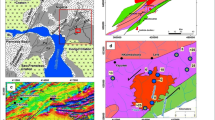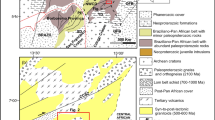Abstract
An investigation of the gold fraction of the Witwatersrand conglomerates from the Orange Free State goldfield (South Africa) has confirmed that the bulk of this metal is concentrated within the bottom parts of the “reefs”, mostly near the footwall contacts. This, together with other criteria, suggests that the distribution of the metal was governed by sedimentary processes. On the other hand, the shape of the gold grains, as well as the general fabric of the gold-enriched layers, often lack conspicuous sedimentary characteristics. Subsequent metamorphism has obviously produced marked structural modifications and a limited textural rearrangement of the gold and its host-rock, thus obliterating to a certain degree the primary alluvial character of the metallization. The large-scale reconstitution of the gold fraction was effected either by a mechanical reshaping of the malleable and ductile gold particles, or by an intermediate solution process followed by reprecipitation. These processes took place more or less in situ. Accordingly, the original sedimentary distribution pattern was not profoundly affected, whereas the individual allogenic gold grains were transformed into authigenic ones or sometimes even into major gold aggregates. Electron-probe microanalysis established that the gold contains on the average between 9.9 and 12.4% silver, which is also suggestive of an alluvial origin. In spite of some uncertainties arising from the camouflaging effect of “pseudohydrothermal” reconstitution processes and from the absence of hydraulic equilibrium between gold and several demonstrably detrital heavy minerals, an integration of all available data strongly supports a modified placer theory for the origin of the Witwatersrand gold.
Zusammenfassung
Eine Untersuchung der Goldführung von Konglomeraten des Oberen Witwatersrand-Systems (Oranje-Freistaat-Goldfeld, Südafrika) zeigt, daß die Verteilung des Metalls eindeutig durch sedimentäre Faktoren gesteuert worden ist, obwohl die Form der einzelnen Goldkörnchen sowie ihre Lagebeziehungen zueinander und zu den übrigen Mineralien nicht in jedem Falle mit gleicher Eindeutigkeit für ein sedimentäres Gefüge sprechen. Für diesen scheinbaren Widerspruch ist die Metamorphose verantwortlich, der die Lagerstätte im Laufe ihrer späteren geologischen Geschichte ausgesetzt war und bei der es zu einer teilweisen Umlagerung der Lagerstättensubstanz kam. Davon wurde auch die Goldfraktion betroffen, die dementsprechend heute kaum noch in ihrer ursprünglichen detritischen Form vorliegt, sondern meist „pseudohydrothermale“ Aggregate bildet. Die Umkristallisation des Goldes erfolgte dabei meist in situ, so daß das ursprüngliche sedimentäre Verteilungsschema ausgezeichnet erhalten geblieben ist. — Der Silbergehalt des Goldes konnte mit 9.8–12.4% bestimmt werden, was gleichfalls für eine detritische Herkunft des Metalls spricht. Berücksichtigt man die späteren Umlagerungsvorgänge, dann bereitet der erzmikroskopische Befund einer Deutung der Konglomerate als Seifen keine Schwierigkeiten, sondern spricht mit überwältigender Wahrscheinlichkeit für eine Seifenumlagerungshypothese.
Similar content being viewed by others
References
Anderson, C. B.: Presidential address, 75th Ann. Meeting, Transvaal and Orange Free State Chamber of Mines. Mining Survey (Johannesburg) 57, 3–16 (1965).
Brock, B. B., L. T. Nel, and D. J. L. Visser: The geological background of the uranium industry. In: Uranium in South Africa 1946–1956. Vol. 1, p. 273–305, Johannesburg: Assoc. Scient. & Techn. Soc. S.Afr. 1957.
Busschau, W. J.: Future trends in world gold production. Mining Survey (Johannesburg) 61, 17–21 (1967).
Cissarz, A.: Einführung in die allgemeine und systematische Lagerstättenlehre. Stuttgart: Schweizerbart 1965.
Clark, L. A.: The Fe-As-S system: phase relations and applications. Econ. Geol. 55, 1345–1381; 1631–1652 (1960).
Davidson, C. F.: On the occurrence of uranium in ancient conglomerates. Econ. Geol. 52, 668–693 (1957).
— Discussion on paper by G. M. Koen. — Trans. Geol. Soc. S.Afr. 64, 47–49, (1961).
— The mode of origin of banket ore-bodies. Trans. Inst. Mining Metallurgy (London), 74, 319–338 (1964/65).
—, and S. H. U. Bowie: On thucholite and related hydrocarbon-uraninite complexes, with a note on the origin of the Witwatersrand gold ores. Bull. Geol. Surv. Gt. Brit. 3, 1–18 (1951).
Friedensburg, F.: Die Bergwirtschaft der Erde (6. Aufl.). Stuttgart: Schweizerbart 1965.
Goni, J., C. Guillemin, and C. Sarcia: Géochimie de l'or exogène. Mineral. Deposita 1, 259–268 (1967).
Graton, L. C.: Hydrothermal origin of the Rand gold deposits. Econ. Geol. 25 (Suppl. to No. 3), 1–185 (1930).
Hargraves, R. B.: Silver-gold ratios in some Witwatersrand conglomerates. Econ. Geol. 58, 952–970 (1963).
Kirchheimer, F.: Über das Rheingold. Jh. Geol. L. A. Baden-Württemberg 7, 55–85 (1965).
Krauskopf, K. B.: The solubility of gold. Econ. Geol. 46, 858–870 (1951).
Kuenen, P. H.: Experimental turbidite lamination in a circular flume. J. Geol. 74, 523–545 (1966).
Liebenberg, W. R.: The occurrence and origin of gold and radioactive minerals in the Witwatersrand System, the Dominion Reef, the Ventersdorp Contact Reef, and the Black Reef. Trans. Geol. Soc. S.Afr. 58, 101–227 (1955).
Lindgren, W.: Mineral deposits. New York: McGraw-Hill 1933.
Mellor, E. T.: The origin of the gold in the Rand banket. Trans. Geol. Soc. S.Afr., Annexure to vol. 34, 55–69 (1931).
Rahden, H. V. R. von: Apparent fineness values of gold from two Witwatersrand gold mines. Econ. Geol. 60, 980–997 (1965).
Ramdohr, P.: Neue Beobachtungen an Erzen des Witwatersrandes in Südafrika und ihre genetische Bedeutung. Abh. dt. Akad. Wiss. Berlin, Kl. Chem. Geol. Biol. 1954, Nr. 5, 43 p. (1955).
--New observation on the ores of the Witwatersrand in South Africa and their genetic significance. Trans. Geol. Soc. S.Afr. 61 (Annexure), 50 p., 1958 (1958a).
--Die Uran- und Goldlagerstätten Witwatersrand, Blind River District, Dominion Reef, Serra de Jacobina: erzmikroskopische Untersuchungen und ein geologischer Vergleich. Abh. dt. Akad. Wiss. Berlin, Kl. Chem. Geol. Biol. 1958, Nr. 3, 35 p. (1958b).
— Rheingold als Seifenmineral. Jh. Geol. L. A. Baden-Württemberg 7, 87–95 (1965).
Reinecke, L.: The location of payable ore bodies in the gold-bearing reefs of the Witwatersrand. Trans. Geol. Soc. S.Afr. 30, 89–119 (1927).
Rittenhouse, G.: Transportation and deposition of heavy minerals. Bull. Geol. Soc. Am. 54, 1725–1780 (1943).
Saager, R.: Newly observed ore-minerals from the Basal Reef in the Orange Free State goldfield in South Africa. Econ. Geol. 63, 116–123 (1968).
Schidlowski, M.: Eine bemerkenswerte Verwachsung von Uranpecherz und Gold aus den Witwatersrand-Konglomeraten. Naturwissenschaften 52, 11 (1965).
— Beiträge zur Kenntnis der radioaktiven Bestandteile der Witwatersrand-Konglomerate. I. Uranpecherz in den Konglomeraten des Oranje-Freistaat-Goldfeldes. N. Jb. Miner. Abh. 105, 183–202 (1966a).
— Beiträge zur Kenntnis der radioaktiven Bestandteile der Witwatersrand-Konglomerate. III. Kohlige Substanz (“Thucholith”). N. Jb. Miner. Abh. 105, 310–324 (1966b).
— Mineralbestand und Gefügebilder in Faseraggregaten von kohliger Substanz (“Thucholith”) aus den Witwatersrand-Konglomeraten. Contr. Mineral. Petrol. 12, 365–380 (1966c).
-- Untersuchungen zur Metallogenese im südwestlichen Witwatersrand-Becken (Oranje-Freistaat-Goldfeld, Südafrika). Habil.-Schrift, Universität Heidelberg (1968), Beiheft z. Geol. Jb., 1969 (in press).
—, and P. Trurnit: Drucklösungserscheinungen an Geröllpyriten aus den Witwatersrand-Konglomeraten. Ein Beitrag zur Frage des diagenetischen Verhaltens von Sulfiden. Schweiz. Miner. Petrogr. Mitt. 46, 337–351 (1966).
Sharpe, J. W. N.: Discussion on paper by W. R. Liebenberg. Trans. Geol. Soc. S.Afr. 58, 229–230 (1955).
Stumpfl, E. F., and A. M. Clark: Electron-probe microanalysis of gold-platinoid concentrates from Southeast Borneo. Trans. Inst. Mining Metallurgy (London) 74, 933–946 (1964/65).
Truschkova, N. N., and A. A. Kucharenko: Atlas der Mineralien von Seifenlagerstätten. Moskau: Wiss.-Techn. Staatsverl. f. Lit. z. Fragen d. Geologie u. d. Schutzes der Bodenschätze 1961.
Wartenweiler, F.: Distribution of gold in banket ore classified products with reference to milling and cyaniding operations. J. Chem. Met. Mining Soc. S.Afr. 21, 217–222 (1921).
Young, R. B.: The banket of the South African goldfields. London: Gurney & Jackson 1917.
Author information
Authors and Affiliations
Rights and permissions
About this article
Cite this article
Schidlowski, M. The gold fraction of the Witwatersrand conglomerates from the Orange Free State goldfield (South Africa). Mineral. Deposita 3, 344–363 (1968). https://doi.org/10.1007/BF00207526
Received:
Issue Date:
DOI: https://doi.org/10.1007/BF00207526




